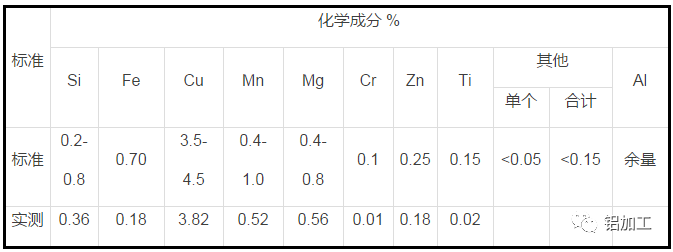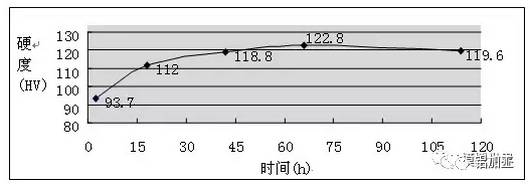1 Introduction 2017 is the first hard-aluminum alloy to be industrially used in Al-Cu-Mg aluminum alloys. Its composition is reasonable and its overall performance is good. The off-line quenching is used in the production of aluminum profiles, and it is used in natural aging conditions. However, the off-line quenching process is cumbersome, and the performance requirements of the heat treatment equipment are also relatively high. Off-line quenching can easily cause local grain coarsening of bars and lower the off-line stability. The dissolution temperature easily leads to insufficient hardness. In this paper, the method of in-line quenching + drawing + artificial aging of aluminum extrusion is studied to produce high-precision, high-hardness 2017 aluminum alloy rods. The effects of different heat treatment processes and drawing processing rates on the properties of 2017 alloy rods are discussed. Through the optimization of heat treatment and drawing process, we have produced products that meet the requirements of customers. Product technical requirements: alloy brand 2017, product diameter φ16.1 ± 0.03mm, hardness ≥ Hv135, delivery length: 2500mm, bending: ≤ 0.6mm/2500mm. 2, aluminum alloy bar production process 2.1 Chemical composition Through the optimal design of aluminum alloys, the chemical composition of aluminum rods is controlled as shown in Table 1: 2017 alloy composition table 1 2.2 Aluminum bar extrusion process Ingot specifications: φ130 × 205mm, 800 tons single-acting indirect extrusion machine extruded into φ17.5mm and φ16.8mm two specifications of bar, extrusion process parameter control in Table 2: Extrusion process parameters table 2 2.3 Heat Treatment The effects of on-line quenching+natural aging, natural aging+artificial aging, natural aging+drawing and artificial aging were investigated to investigate the effect on hardness and bending of the product. 2.4 drawing processing rate The aluminum rods of φ17.5mm and φ16.8mm sizes were drawn to φ16.1mm bars using different machining rates to verify the effect of different processing rates on the hardness and bending of the products. 3, test program The φ17.5mm and φ16.8mm rods, which have been subjected to reverse extrusion in-line quenching, are tested in the following manner during the production process: 3.1 The extruded bars were aged for 2 h, 5 h, 10 h, 24 h, 36 h, 48 h, 72 h, and 110 h, and the hardness after natural aging was measured. 3.2 After natural aging for 2.5h and 36h, artificial aging was performed again to test the effect on the hardness of subsequent artificial aging. 3.3 The natural aging of the bar after the "pull + artificial aging" deformation heat treatment, testing its impact on the hardness; 3.4 The effect of different drawing processing rates on hardness and bending of bars was examined. 4, experimental results and analysis 4.1 Natural aging test after extrusion quenching Take the online quenching, the diameter of φ16.8 ± 0.10mm bar sample 10, placed 2h, 5h, 10h, 24h, 36h, 48h, 72h, 110h natural aging, hardness measurement, drawing the natural aging hardness curve shown in Figure 1. Fig.1 The natural age hardening curve of alloy 2017 It can be seen from Fig. 1 that after online quenching of the 2017 alloy extruded bar, the natural ageing reaches the peak hardness for 3 days, and the maximum hardness can reach Hv120 or so. 4.2 Artificial aging after natural aging Take in-line water-cooled quenching, diameter of 16.8 ± 0.10mm bar sample 20, natural aging 2.5h, 36h, and then (170 °C × 8h) artificial aging, the measured hardness in Table 3. Artificial aging after natural aging Table 3 From the data in Table 3, it can be seen that the final hardness achieved by artificial aging for 2.5 hours or 36 hours after natural aging is basically the same as the peak hardness achieved by natural aging. 4.3 Natural aging after drawing and artificial aging test Thirty-six bar samples with a diameter of φ16.8±0.10mm were sampled by in-line water-cooled quenching and were naturally aged at 2h, 18h, and 42h, respectively, and then drawn to specifications of φ16.1mm bar, and then subjected to artificial aging (170°C×8h). The measured hardness is shown in Table 4. Hardness after natural aging after artificial aging From Table 4, it can be seen that when the drawing processing rate is not changed, the natural aging time can increase the bar hardness after “pulling+artificial agingâ€, and after 18 hours natural aging, the “drawing+artificial aging†hardness is performed. Values ​​can meet product specifications. 4.4 Effect of Drawing Rate on Hardness of Bars Take 10 rods of diameter φ17.5mm and φ16.8mm bars, and pull them into φ16.1mm after 18 hours of natural aging. The processing rates are 15.3% and 8.2%, respectively, and then artificial aging (170°C×8h) is performed. The average hardness is shown in Figure 2. Figure 2 Effect of different drawing processing rates on the final hardness of the product 4.5 Experiments on the Effect of Drawing Rate on Bending Rate When the φ17.5mm bar was pulled once to a φ16.1±0.02mm product, the processing rate was 15.3%. Due to the excessive processing rate, the residual stress of the product is large, the surface of the product is easily scratched, and the product is severely bent. After repeated straightening, the bending requirement cannot be satisfied. Afterwards, the three-pass drawing process was used: the first pass was drawn from φ17.5mm to φ16.9mm, the second pass was drawn from φ16.9mm to φ16.4mm, and the third pass was drawn from φ16.4mm to φ16. 1±0.02mm, the processing rate was 6.7%, 5.8%, and 3.6%, respectively. Although the scratch on the surface of the product was reduced and the bending was improved to some extent, the pass rate of the product was still very low, only 35.6. %qualified. While taking 27 pieces of φ16.8mm bars to pull φ16.1±0.02mm products at a time, the processing rate was 8.2%. After straightening, the finished product was sawed into 2500 mm. All the bending tests were qualified. The results are shown in Table 5. Bend Test Results Table 5 5 Conclusion 5.1 In the above aluminum extrusion process conditions, the maximum hardness value of natural alloys after quenching on-line quenched by 2017 alloys can only reach about Hv120 after 3 days. Artificial aging after natural aging has no obvious effect on hardness. 5.2 The elongation of natural aging time before drawing aluminum alloy bars can increase the artificial aging hardness after drawing. 5.3 Increasing the drawing rate of aluminum profiles can increase the hardness of aluminum products after artificial aging. 5.4 Under the same drawing conditions, the drawing processing rate has an effect on the bending of the product, and the greater the processing rate, the greater the bending; 5.5 Extrusion outlet temperature of aluminum extrusion controlled at 470 °C in-line quenched φ16.8mm extrusion billet, after natural aging more than 18h, once drawn into φ16.1 ± 0.02mm bar, and then (170 °C × 8h) artificial Aging can meet the technical requirements of HV ≥ 135, straightness ≤ 0.6mm/2500mm.
Automatic Swing Door Parts mainly include hinges, closers, openers, electrical plug-in locks and locksets. Each hinge consists of 37 parts which keeps the swing door leaf straight. Ningbo GDoor uses world-known brands' closers and openers, satisfying high security requirements. And the build-in microchip of electrical plug-in lock has functions like lock mode and door status test. When the fire occurs, the electrical plug-in lock will open automatically after the power failed. KBB locksets conform to GB 9303-88 standard.
Automatic Swing Door Parts Automatic Swing Door Parts,Automatic Sliding Door Parts,Electric Sliding Doors Parts,Automatic Glass Doors Parts Ningbo Gdoor System Control Technology Co., Ltd. , http://www.gdoor-cn.com






20 series hard aluminum alloy bar extrusion production process